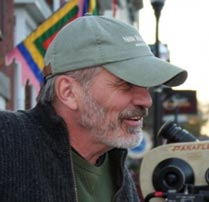Part 12, Editing the film
 Next we headed into the post production process, which lasted from the end of the shoot in mid-November until the end of April–approximately five and a half months.
Next we headed into the post production process, which lasted from the end of the shoot in mid-November until the end of April–approximately five and a half months.
The first step, once we’d caught our breath after the wrap party, was to begin the editing of the film. We were fortunate to be able to rent an isolated and beautiful country house for this purpose right next door to my home in the Stoddard hills of southwest New Hampshire and just up the road from where Aaron lived. Our editor Mario Ontal, who had worked on a number of John Sayles’ films, moved up from New York City and took up residence there, and we had all our rented Avid editing equipment trucked up from NYC and installed in a first floor bedroom.
I should explain that for films shot on 35mm, the editing process today–and I’m simplifying this obviously–involves transferring the 35mm film used to actually shoot the movie to a digital version and then that digital version is edited by computer. Then when the digital version of the film is completely finished it is eventually transferred back to 35mm. The process allows for much more flexibility in editing and makes available a wide range of special effects that until a few years ago were generally out of reach financially for low-budget independent filmmakers.
For three months Aaron and Mario worked constantly and tirelessly on the film, cutting and experimenting, moving scenes around, making adjustments, trying out various music pieces with scenes and sequences, and finally coming up with the first rough cut of the film. From time to time I’d walk over through the woods from my house to take a peek at their progress, but for the most part made a point of letting Aaron and Mario work away undisturbed in their isolation. They were making great progress and enjoying the process so the last thing they needed was for their producer to be breathing down their necks and peering over their shoulders. To be honest I suspect that if I wasn’t liking what I was peeking at when I did show up, I probably would have made more frequent visits.
This was probably my most favorite time in the entire process of producing the movie. No pressure. No army of people on payroll. No constant problem solving. Just quiet, steady progress on our movie, which was becoming a reality–our story coming to life on the screen, albeit so far seen only on a small computer monitor. It was truly exhilarating to see it all come together with picture, sound, and music. And as it progressed we increasingly knew that we had in the making the film we wanted to make. Our excitement steadily built throughout these weeks of peaceful and undisturbed work in our woods.
By mid-January, because money was running out to keep Mario longer and because all of us were ready to take a look at our work in progress on the big screen with an audience, we made arrangements for several public screenings. The Film Department at nearby Keene State College had graciously offered us their lovely 150-seat Putnam Theatre on campus, so on three Saturday mornings in January and early February we invited friends and crew members and shared the film with between 50 and 80 people at each digitally-projected screening. Most of our producers attended at least one of these and David Strathairn and his wife joined us for one as well.
After each showing we’d listen to feedback and then make adjustments based on our notes and how we felt it played before audiences that were experiencing the material for the first time. These screenings were invaluable for Aaron and Mario as they continued their work on pacing and flow. We were also very encouraged, as all three audiences were absorbed in our story as it unfolded and seemed very moved by the film.
(Next: Post production takes us off to Los Angeles...)













Keene sounds like a great place to live. Whole area sounds supportive of filmmakers.
An interesting aspect of making movies in New Hampshire–and one of the reasons we base our company here–is that there’s a growing community of indie filmmakers in the state that all support each other and work on each other’s projects. And it’s almost all truly indie work, meaning that it’s largely locally financed and the stories are our stories–not outsiders coming in with outside money and producing their films here because they can do it cheaper (not that there’s anything wrong with that). Also, this is not to say that we don’t work with top industry talent when we have the opportunity. And many of us have also worked on Hollywood films–some very big budget Hollywood films. But it’s a great thing to get back to basics doing the thing you love to do and what’s happening up here in NH is pretty exciting as we keep doing more of our “little” indie projects. Now all we have to do is figure out how we can do this on a steady basis and still put food on the table…